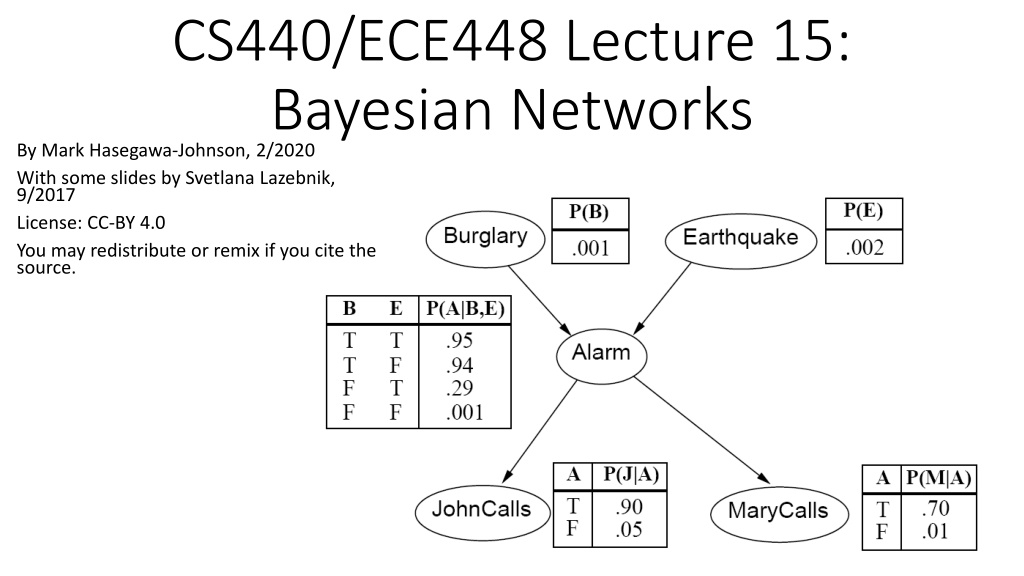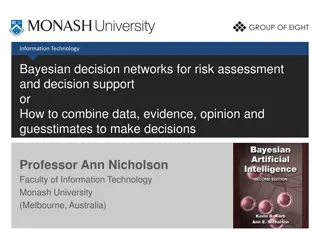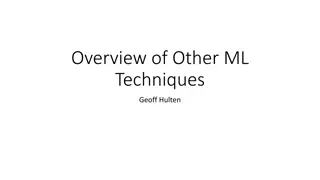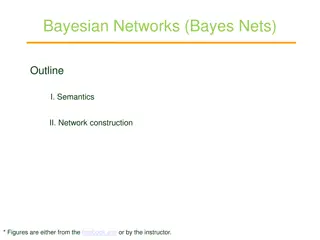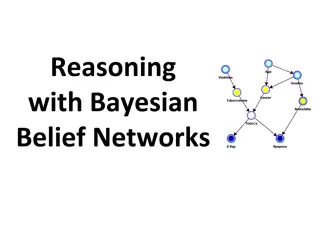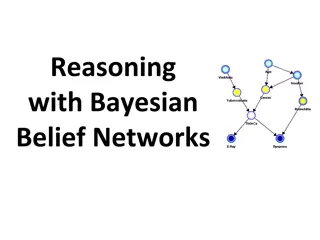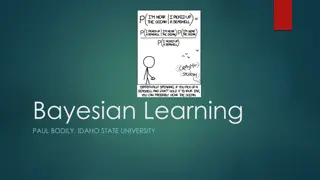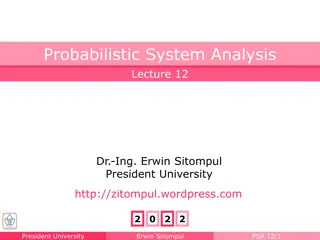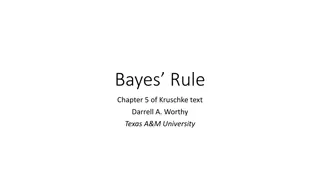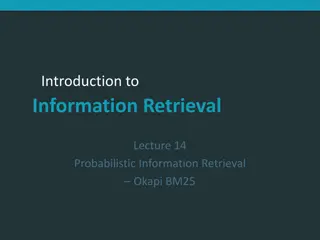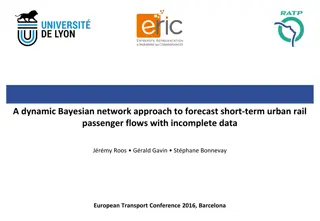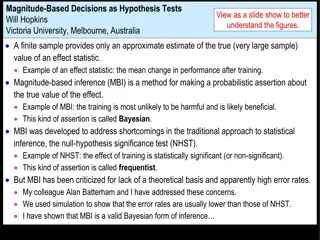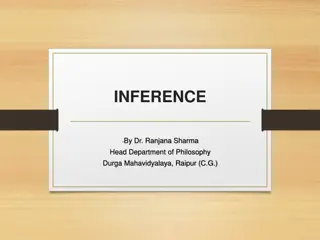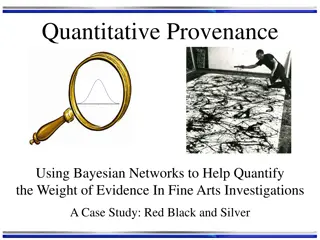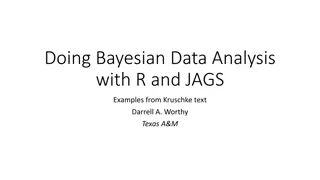Understanding Bayesian Networks for Efficient Probabilistic Inference
Bayesian networks, also known as graphical models, provide a compact and efficient way to represent complex joint probability distributions involving hidden variables. By depicting conditional independence relationships between random variables in a graph, Bayesian networks facilitate Bayesian inference for answering queries about query variables given evidence variables. The structure of Bayesian networks, consisting of nodes representing random variables and directed edges denoting dependencies, enables efficient inference through the graphical model semantics.
- Bayesian Networks
- Graphical Models
- Probabilistic Inference
- Conditional Independence
- Hidden Variables
Download Presentation

Please find below an Image/Link to download the presentation.
The content on the website is provided AS IS for your information and personal use only. It may not be sold, licensed, or shared on other websites without obtaining consent from the author. Download presentation by click this link. If you encounter any issues during the download, it is possible that the publisher has removed the file from their server.
E N D
Presentation Transcript
CS440/ECE448 Lecture 15: Bayesian Networks By Mark Hasegawa-Johnson, 2/2020 With some slides by Svetlana Lazebnik, 9/2017 License: CC-BY 4.0 You may redistribute or remix if you cite the source.
Review: Bayesian inference A general scenario: Query variables:X Evidence (observed) variables and their values: E = e Inference problem: answer questions about the query variables given the evidence variables This can be done using the posterior distribution P(X | E = e) Example of a useful question: Which X is true? More formally: what value of X has the least probability of being wrong? Answer: MPE = MAP (argmin P(error) = argmax P(X=x|E=e))
Today: What if P(X,E) is complicated? Very, very common problem: P(X,E) is complicated because both X and E depend on some hidden variable Y SOLUTION: Draw a bunch of circles and arrows that represent the dependence When your algorithm performs inference, make sure it does so in the order of the graph FORMALISM: Bayesian Network
Hidden Variables A general scenario: Query variables:X Evidence (observed) variables and their values: E = e Unobserved variables: Y Inference problem: answer questions about the query variables given the evidence variables This can be done using the posterior distribution P(X | E = e) In turn, the posterior needs to be derived from the full joint P(X, E, Y) e X e E X ) ( P ( , ) P = = X e y ( | ) ( , , ) P P e y Bayesian networks are a tool for representing joint probability distributions efficiently
Bayesian networks More commonly called graphical models A way to depict conditional independence relationships between random variables A compact specification of full joint distributions
Outline Review: Bayesian inference Bayesian network: graph semantics The Los Angeles burglar alarm example Inference in a Bayes network Conditional independence Independence
Bayesian networks: Structure Nodes: random variables Arcs: interactions An arrow from one variable to another indicates direct influence Must form a directed, acyclic graph
Example: N independent coin flips Complete independence: no interactions X1 X2 Xn
Example: Nave Bayes document model Random variables: X: document class W1, , Wn: words in the document X W1 W2 Wn
Outline Review: Bayesian inference Bayesian network: graph semantics The Los Angeles burglar alarm example Inference in a Bayes network Conditional independence Independence
Example: Los Angeles Burglar Alarm I have a burglar alarm that is sometimes set off by minor earthquakes. My two neighbors, John and Mary, promised to call me at work if they hear the alarm Example inference task: suppose Mary calls and John doesn t call. What is the probability of a burglary? What are the random variables? Burglary, Earthquake, Alarm, JohnCalls, MaryCalls What are the direct influence relationships? A burglar can set the alarm off An earthquake can set the alarm off The alarm can cause Mary to call The alarm can cause John to call
Conditional independence and the joint distribution Key property: each node is conditionally independent of its non-descendants given its parents Suppose the nodes X1, , Xn are sorted in topological order To get the joint distribution P(X1, , Xn), use chain rule: n ( ) = i = i = ( , , ) | , , P X X P X X X 1 1 1 n i i 1 n ( ) = | ( ) P X Parents X i i 1
Conditional probability distributions To specify the full joint distribution, we need to specify a conditional distribution for each node given its parents: P(X| Parents(X)) Z1 Z2 Zn X P(X| Z1, , Zn)
Example: Burglar Alarm ?(?) ?(?) ?(?|?,?) ?(?|?) ?(?|?)
Example: Burglar Alarm ?(?) ?(?) A model is a complete specification of the dependencies. The conditional probability tables are the model parameters. ?(?|?,?) ?(?|?) ?(?|?)
Outline Review: Bayesian inference Bayesian network: graph semantics The Los Angeles burglar alarm example Inference in a Bayes network Conditional independence Independence
Classification using probabilities Suppose Mary has called to tell you that you had a burglar alarm. Should you call the police? Make a decision that maximizes the probability of being correct. This is called a MAP (maximum a posteriori) decision. You decide that you have a burglar in your house if and only if ? ???????? ???? > ?( ????????|????)
Using a Bayes network to estimate a posteriori probabilities Notice: we don t know ? ???????? ???? ! We have to figure out what it is. This is called inference . First step: find the joint probability of ? (and ?), ? (and ?), and any other variables that are necessary in order to link these two together. ? ?,?,?,? = ? ? ? ? ? ? ?,? ? ? ? ? ???? ?, ? ?,? ?, ? ?,? ?, ? 0.986045 2.99 10 4 1.7 10 4 9.96 10 3 1.4 10 5 6.98 10 4 1.4 10 3 ?,? 4.06 10 4 ?, ? 5.93 10 5 9.9 10 8 2.81 10 4 5.7 10 7 5.99 10 7 10 9 6.57 10 4 ?,? 1.33 10 6
Using a Bayes network to estimate a posteriori probabilities Second step: marginalize (add) to get rid of the variables you don t care about. ? ?,? = ?(?,?,?,?) ?, ? ?, ? ? ?,? ? ? ? 0.987922 0.011078 ? 0.000341 0.000659
Using a Bayes network to estimate a posteriori probabilities Third step: ignore (delete) the column that didn t happen. ? ?,? ? ? 0.011078 ? 0.000659
Using a Bayes network to estimate a posteriori probabilities Fourth step: use the definition of conditional probability. ?(?,?) ? ? ? = ? ?,? + ?(?, ?) ? ?|? ? ? 0.943883 ? 0.056117
Some unexpected conclusions Burglary is so unlikely that, if only Mary calls or only John calls, the probability of a burglary is still only about 5%. If both Mary and John call, the probability is ~50%. unless
Some unexpected conclusions Burglary is so unlikely that, if only Mary calls or only John calls, the probability of a burglary is still only about 5%. If both Mary and John call, the probability is ~50%. unless If you know that there was an earthquake, then the probability is, the alarm was caused by the earthquake. In that case, the probability you had a burglary is vanishingly small, even if twenty of your neighbors call you. This is called the explaining away effect. The earthquake explains away the burglar alarm.
Outline Review: Bayesian inference Bayesian network: graph semantics The Los Angeles burglar alarm example Inference in a Bayes network Conditional independence Independence
The joint probability distribution n ( ) = i = ( , , ) | ( ) P X X P X Parents X 1 n i i 1 For example, P(j, m, a, b, e) = P( b) P( e) P(a| b, e) P(j|a) P(m|a)
Independence By saying that ??and ??are independent, we mean that P(??,??) = P(??)P(??) ??and ?? are independent if and only if they have no common ancestors Example: independent coin flips X1 X2 Xn Another example: Weather is independent of all other variables in this model.
Conditional independence By saying that ??and ??are conditionally independent given ?, we mean that P ??,??? = P(??|?)P(??|?) ??and ??are conditionally independent given ? if and only if they have no common ancestors other than the ancestors of ?. Example: na ve Bayes model: X W1 W2 Wn
Conditional independence Independence Common cause: Conditionally Independent Common effect: Independent Are X and Z independent? No Are X and Z independent? Yes ?(?,?) = ?(?)?(?) ? ?,? = ? ? ? ? ? ? ?(?) ? Are they conditionally independent given Y? No ? ?,? ? =? ? ?,? ? ? ?(?) ? ? ? ? = ? ? ? ?(?) ? ? ? ?(?) ? ? ?(?) Are they conditionally independent given Y? Yes ? ?,? ? = ?(?|?)?(?|?) ? ?|? ? ?|?
Conditional independence Independence Common cause: Conditionally Independent Common effect: Independent Are X and Z independent? No Are X and Z independent? Yes Knowing X tells you about Y, which tells you about Z. Knowing X tells you nothing about Z. Are they conditionally independent given Y? Yes Are they conditionally independent given Y? No If Y is true, then either X or Z must be true. Knowing that X is false means Z must be true. We say that X explains away Z. If you already know Y, then X gives you no useful information about Z.
Conditional independence Independence X W1 W2 Wn Being conditionally independent given X does NOT mean that ??and ??are independent. Quite the opposite. For example: The document topic, X, can be either sports or pets , equally probable. W1=1 if the document contains the word food, otherwise W1=0. W2=1 if the document contains the word dog, otherwise W2=0. Suppose you don t know X, but you know that W2=1 (the document has the word dog ). Does that change your estimate of p(W1=1)?
Conditional independence Another example: causal chain X and Z are conditionally independent given Y, because they have no common ancestors other than the ancestors of Y. Being conditionally independent given Y does NOT mean that X and Z are independent. Quite the opposite. For example, suppose P(?) = 0.5, P ? ? = 0.8, P ? ? = 0.1, P ? ? = 0.7, and P ? ? = 0.4. Then we can calculate that P ? ? = 0.64, but P(?) = 0.535
Outline Review: Bayesian inference Bayesian network: graph semantics The Los Angeles burglar alarm example Inference in a Bayes network Conditional independence Independence
